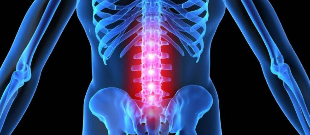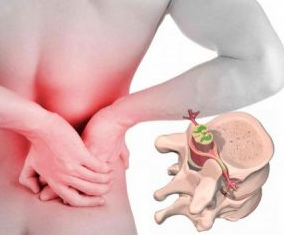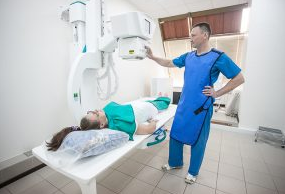Degenerative disease, which destroys the body of the vertebrae deformed disc, called osteochondrosis of the lumbar spine. The causes of this pathology can be diverse and varied, and for self care, it is important to determine exactly what has affected the progression of the deformity in the back. If the person disrupts the characteristic symptoms of the degenerative disease of the disk, you must immediately go to the hospital.
In step 1 is unable to cure the problem of drugs and exercises, but 2-3 degrees conservative method is not always useful, which is why it is necessary to resort to a method and a surgical treatment.

The main causes of the
On the left side or right side lumbar pain in the lower back — a degenerative disease of the nature, which destroys the intervertebral disc, torn fibrous ring and a hernia, causing acute pain and an alteration in the functioning of the musculo-skeletal system. Cause pain in the lower back back can the following factors:
- increased physical activity on the lower part of the spine;
- bad position of the body during walking, the seat;
- the lack of a sedentary life-style;
- deteriorated posture;
- injuries, fractures or contusions, causing the degenerative consequences of the spinal column;
- congenital malformations of the structure, musculo-skeletal, including the signs of the deformation observed in the child;
- obesity;
- stress, a poor diet.
The stage and the symptoms
The signs of degenerative disc disease of the lumbar spine, and are developed to measure the progression of the disease, and the higher the stage, the more manifests a symptom. There are 4 degrees:
- In step 1, the fibrous ring is damaged, there is no significant, pain is not expressed, and are often anxious after a long walk. The pain manifests itself in 2 types — lumbalgia, when a symptom of disturbing constantly, and lumbago, in which the symptoms occur suddenly.
- Osteochondrosis of the POP of degree 2 is characterized by a destruction of the fibrotic ring and the degeneration of the disc. Such a violation results in a decrease of the space between the vertebrae and the tightening of the nerve fibers. Progressive 2 stage is accompanied by pain in the lower back, in the morning, feel the stiffness of the time does not pass.
- On 3 stages, a fibrous ring in the affected area has been completely destroyed, because of what is formed of a hernia, which squeezes the blood vessels and the spinal nerve roots. Back hurts constantly, the symptoms recede after a stay of relaxation and to reduce the burden, we feel a sensation of tingling and heaviness in the legs. In the third degree occurs a degeneration of the muscular fibres, in consequence of which restricted the movements of the patient.
- On the 4 stages of the spinal column is deformed completely, the man is worried about acute pain, due to which physical activity is entirely limited. Because of the violation of the innervation and vascularization appear swelling of the legs, between the vertebrae multiply bone of education. On the last degree of high risk of morbidity.
The syndromes of degenerative disc disease of the lumbar spine
Lumbar osteochondrosis is manifested syndromes of the following:
- Of the pain. This is the main symptom of the characterizing degenerate-degenerative disorders of the spine. As the progression of the pathology, the symptoms become severe, the attacks can last from a few days, have a negative impact on the health of man.
- Root. Because of the thinning damaged the body of disc height of the intervertebral space decreases, due to which the vertebrae become unstable, annoying, and squeezing the nerve endings. The man worried about acute pain syndrome, inflammation of the nerves, circulatory disorders. The carcass of the atrophy, to which the functionality of the lower limbs is disturbed.
- Ischemic. Progressing osteochondrosis of the lumbar spine and the division leads to the fact that the blood vessels and arteries, penetrating the spine begin to compress. This disrupts the blood circulation and nutrition of internal organs and tissues, and becomes the cause of acute pain in the inner side of the thighs in the perineal area. If the problem is not resolved in a timely manner, the risk of paralysis or paresis.
- Vertebral. During the progression of the pain, ischemic events and radicular syndromes of the vertebral column of the patient deforms gradually, which has greatly affected the state of well-being. The muscles become weak, and the evolution of the process, a person tries to distribute the load on the spine so that, when the movement to experience a minimum of discomfort. Such violations have an impact on the functioning of the internal organs, in so doing, the intervertebral discs, there is still more to deform and be damaged.

If the treatment of degenerative disc disease of the lumbar has been insufficient, or of a place outside of time, may develop complications that are dangerous. Among the women in the defeat of the vertebrae at levels L1—S1, complications can occur during pregnancy, especially on the last words, when the load on the spine maximum. In men, the degenerative processes in the lumbar spine are often the cause of impotence problems. Late, the treatment of the threat of a reaction, spondylosis, as well as the high probability of development of osteoarthritis of the knee, hip. Appearance of other effects:
- the compression, vascular ischemia;
- protrusion;
- spondiloarthrosis;
- paresis.
The diagnosis
So that the doctor can pick up effective treatment, it is necessary to establish a precise diagnosis. The diagnosis begins in the office of the neurologist, who conducts the initial review, the palpated the affected area, evaluates the nature of the changes in the vertebral column. In the acute period of the patient can hardly move, and perform complex editing. For a more detailed explanation of the study of the spine is named instrumental diagnosis, which includes:
- X-rays. Is done in 3 projections, the images show the degree of progression of the pathology, the size of the intervertbral cracks, salt deposits, the structure of the spine.
- The CT or MRI. To give a more detailed picture of the state of the spine and the discs, show irregularities in the soft tissues, which cannot be considered during the radiographic examination.
How to treat the problem?
Drugs
The disease is characterized by the progression of the pain symptom, which face do may not all drugs. In the initial stages for the relief of symptoms you can take painkillers. And the problem is treated using ointments and gels. In the case of these medicines prove to be ineffective, so the doctor will prescribe you injections, thanks to which analgesia and first aid in a timely manner.

Non-steroidal anti-inflammatory drugs help to relieve swelling and inflammation, and as a result the nerve fibers and the blood vessels will cease to compress, and the symptoms of the pain subsides. The group is composed of tools:
- Analgesics. With the progression of the acute period, when the pain pronounced, are appointed by the medicines of this group. Because they do have side effects, not worth it to buy the means at its sole discretion. Safe and effective the drug must appoint a physician.
- Muscle relaxants. Relieve muscle spasms, due to the reduction of the pain and discomfort.
- The corticosteroids. Eliminate the inflammation, a positive effect on the nervous system, improve the patient's condition in a short period of time.
Exercises
If diagnosed degenerative disc disease, L5—S1 is amazed of disks at L3—S1, necessarily affected the gymnastics medical. During the execution of the training, the complex it is important to increase the load gradually to avoid discomfort and pain. It is recommended to make low back pain the following exercises:
- In a standing position, make turns to the left and to the right, rocking back and forth.
- Standing on its four legs, bend and align the back.
- Lying on the ground, up the smooth legs, keeping the lower back to the ground.
- In the supine position with the left hand slide toward the ends, which is to the right and vice-versa.
Massage and physiotherapy
Chronic low back pain in the remission phase is successfully treated with the help of massages and treatments provided to the therapist. Massage helps to normalize the blood circulation to the exposed surface, to establish the nutrition. Look like is the impact of physiotherapy treatment:
- the electrophoresis;
- the magneto-therapy;
- laser therapy;
- UHF.
If the patient with driving on the left or to the right, osteochondrosis methods of conservative and did not help, therefore, without surgical treatment is not essential. The more often microdiscectomy, in which are deleted sequestered hernia with the aid of microsurgery tools. The procedure is minimal psidium, the day after the operation, the patient may begin to move.
Prevention
As the osteochondrosis suffer adults and children, it is important from the youngest age, to follow the spinal column, to control posture, to pay attention to what it's like bending when you are sitting or movement. If there is a hint on the deformation, we appeal to a doctor. The sooner will be diagnosed with the disease, the more it will be then to fight.

















